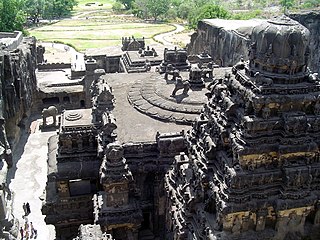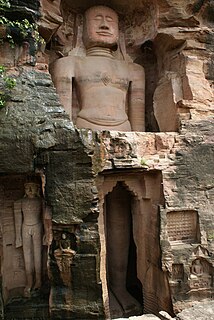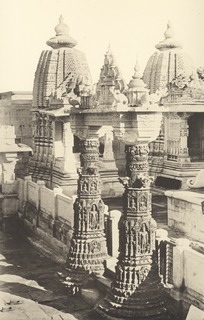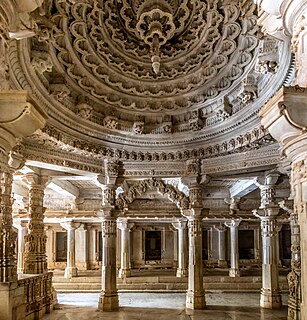
Ellora is a UNESCO World Heritage Site located in the Aurangabad district of Maharashtra, India. It is one of the largest rock-cut monastery-temple cave complexes in the world, featuring Hindu, Buddhist and Jain monuments, and artwork, dating from the 600–1000 CE period. Cave 16, in particular, features the largest single monolithic rock excavation in the world, the Kailash temple, a chariot shaped monument dedicated to Lord Shiva. The Kailash temple excavation also features sculptures depicting the gods, goddesses and mythologies found in Vaishnavism, Shaktism as well as relief panels summarizing the two major Hindu Epics.

Tamil Jains are Tamils from Tamil Nadu, India, who practice Digambara Jainism. The Tamil Jain is a microcommunity of around 85,000, including both Tamil Jains and north Indian Jains settled in Tamil Nadu. They are predominantly scattered in northern Tamil Nadu, largely in the districts of Madurai, Viluppuram, Kanchipuram, Vellore, Tiruvannamalai, Cuddalore and Thanjavur. Early Tamil-Brahmi inscriptions in Tamil Nadu date to the 3rd century BCE and describe the livelihoods of Tamil Jains. Samaṇar wrote much Tamil literature, including the important Sangam literature, such as the Nālaṭiyār, the Silappatikaram, the Manimekalai and the Seevaka Sinthamaṇi. Three of the five great epics of Tamil literature are attributed to Jains.

The Dilwara Temples or Delvada Temples are a group of svetambara Jain temples located about 2 1⁄2 kilometres from the Mount Abu settlement, Rajasthan's only hill station. The earliest were built by Vimal Shah and supposedly designed or at least financed by Vastupala, Jain minister of Dholka. They date between the 11th and 16th centuries, forming some of the most famous monuments in the style of Māru-Gurjara architecture, famous for their use of a very pure white marble and intricate marble carvings. They are a pilgrimage place for Jains, and a significant general tourist attraction. Although Jains built many temples at other places in Rajasthan, the Dilwara temples are believed to be the most impressive.

Neminatha, also known as Nemi and Arishtanemi, is the twenty-second tirthankara (ford-maker) in Jainism. Along with Mahavira, Parshvanatha and Rishabhanatha, Neminatha is one of the twenty four tirthankaras who attract the most devotional worship among the Jains.
Jainism is an ancient Indian religion belonging to the śramaṇa tradition. It prescribes ahimsa (non-violence) towards all living beings to the greatest possible extent. The three main teachings of Jainism are ahimsa, anekantavada (non-absolutism), aparigraha (non-possessiveness). Followers of Jainism take five main vows: ahimsa, satya, asteya, brahmacharya (chastity), and aparigraha. Monks follow them completely whereas śrāvakas (householders) observe them partially. Self-discipline and asceticism are thus major focuses of Jainism.

In Jainism, Ambika or Ambika Devi is the Yakṣi "dedicated attendant deity" or Śāsana Devī "protector goddess" of the 22nd Tirthankara, Neminatha. She is also known as Ambai, Amba, Kushmandini and Amra Kushmandini. She is often shown with one or more children and often under a tree. She is frequently represented as a pair with a small Tirthankar image on the top. The name ambika literally means mother, hence she is Mother Goddess. The name is also a common epithet of Hindu Goddess Parvati.

Jainism in North Karnataka flourished under the Chalukyas, Kadamba, Rashtrakutas, and Vijayanagara empire. Imbued with religious feeling, patronage was extended towards the building of Jain temple and it garnered high repute among the people, particularly the ruling classes and the mercantile community; effectively getting treated as the state religion.

Shri Mahavir Ji is an important Jain pilgrimage site situated in Shri Mahaveerji town in Hindaun Block, Karauli district in Rajasthan. Given the importance of the religious place, the Indian Railways has specifically developed a railway station under West Central Railway zone by the name of Shri Mahabirji railway station which is 10 minutes drive from the temple and temple authorities have arranged for regular buses from station to the temple
Polur taluk is a taluk of Tiruvannamalai district of the Indian state of Tamil Nadu. The headquarters is the town of Polur.

Jainism has an extensive history in the Indian state of Tamil Nadu, although practiced by a minority of Tamils in contemporary times. According to the 2011 India Census, Jains represent 0.12% of the total population of Tamil Nadu, and are of the Digambara sect. Tamil Jains are primarily concentrated in northern Tamil Nadu, in the districts of Madurai, Viluppuram, Kanchipuram, Vellore, Tiruvannamalai, Cuddalore and Thanjavur.

Jain sculptures or Jain idols are the images depicting Tirthankaras. These images are worshiped by the followers of Jainism. The sculpture can depict any of the twenty-four tirthankaras with images depicting Parshvanatha, Rishabhanatha, or Mahāvīra being more popular. Jain sculptures are an example of Jain art. There is a long history of construction of Jain sculptures. Early examples include Lohanipur Torsos which has been regarded to be from the Maurya period, and images from the Kushan period from Mathura.

Ranakpur Jain temple or Chaturmukha Dharana Vihara is a Śvētāmbara Jain temple at Ranakpur is dedicated to Tirthankara Rishabhanatha. The temple is located in a village of Ranakpur near Sadri town in the Pali district of Rajasthan.

Arahanthgiri Jain Math is a Jain Matha that established near Tirumalai in August, 1998. The Math is headed by Bhattaraka Dhavalakeerthi.

Jain art refers to religious works of art associated with Jainism. Even though Jainism spread only in some parts of India, it has made a significant contribution to Indian art and architecture.

Gopachal rock-cut Jain monuments, also called Gopachal Parvat Jaina monuments, are a group of Jain carvings dated to between 7th and 15th century. They are located around the walls of the Gwalior Fort, Madhya Pradesh. They depict Tirthankaras in seated Padmasana posture as well as standing Kayotsarga posture, in the typical naked form of Jain iconography.

The Mahavira Jain temple is built in Osian of Jodhpur District, Rajasthan. The temple is an important pilgrimage of the Oswal Jain community. The temple is visited by both Jain and Hindu.

Kere Basadi or Chaturmukha Basadi is a Jain temple located in Varanga village in Udupi district of Karnataka, India. This 12th-century temple is situated amidst of a lake giving it the name Kere Basadi. The temple is also known Chaturmukha Basadi as it houses a chaturmukha (four-faced) idol of tirthankaras. The temple is situated 26 km from Karkala, another popular Jain centre.

Vallimalai Jain caves are located in Vallimalai village in Katpadi taluk of Vellore district, Tamil Nadu.

The Kumbharia Jain temples are five Śvētāmbara Jain temples in the Kumbhariya, Banaskantha district in Gujarat, India. Constructed from 1062 to 1231 CE during the reign of the Chaulukya dynasty, they are noted for their elaborate architecture.


























